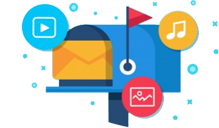1. Use Metrics
Before you start using Salesforce, it’s important to decide the key metrics that will be tracking through dashboards. Analyze and think upon the metrics that define the success of your organization at every level.
Also, finalize the timeline during which these metrics should be evaluated. It can be either monthly, bi-quarterly, or quarterly. To lock your metrics requirements, you can take help from your Sales CRM Consulting Team.
2. Dashboards Designing
If you have less knowledge about Salesforce and its functionality, you don’t need to build your dashboard from scratch. Integrate your platform with AppExchange and download a wide range of free dashboard templates in minutes. You can edit these templates as per your convenience and organization’s needs.
Customizing these existing dashboards not only saves you time but also gives an idea on how to design dashboards and create reports.
3. Use Executive Dashboards
Having executive dashboards or one primary KPI dashboard helps in providing all key metrics of the organization into a single view.
Each functional area or department has many additional dashboards that present the details behind every activity of KPI dashboards. But these details should be used by only concerned people focusing on the specific area of work.
4. Add More Data to Salesforce
If you want to maximize the performance of Salesforce dashboards, bring additional data to it. Let’s assume that the Salesforce Dashboards have only KPIs stored and the operational or business metrics are in Reports. That means, your dashboards are not the single source of information.
With many different tools available, you can turn your Salesforce dashboards as the authoritative source of information.
5. Email Your Dashboards
If you are using the Salesforce Enterprise Edition to schedule the daily or weekly refresh of your dashboards. You can also send your dashboards information through emails. These would be HTML emails that look identical to your dashboards, same graphics, same charts, everything in your mailbox.
You can click on these emails and go through the source report in Salesforce.
Emailing the dashboard automatically with every refresh is good for the team and executive communication.
It’s a handy way to transfer information to your team members on daily basis. And the best part is that your employees won’t have to log in to dashboards to check the latest information every day.
Whether it’s about updating the information of daily work, incoming leads, conversions, or anything, you will stay updated.
6. Remove Unnecessary Elements
Just as your phone works faster with fewer things on it, dashboards also work great with fewer components.
To boost the dashboard’s speed, you can merge multiple data components into one. Let’s assume your dashboard has two bar charts, one shows the sum of the amount, and the other shows the average. Instead of keeping these two separate charts, you can consolidate them into one.
The dashboard will still present the sum and average of the amount separately.
Similarly, in reports, you can remove the default columns that are commonly used in all report types and don’t make any sense to you.
7. Use Filters to Speed Up Reports
To ensure better visualization of data in reports, you can use filters to limit the number of records returned.
However, filters don’t always speed up the reports functioning. Some filters with complex logic can even slow down the reports. So, it’s important to take the help of Salesforce CRM consulting experts to help you with report performance optimization through filters.
8. Constant Maintenance
As your business grows, you will need to enhance the functionality of your system over time. If you have a strong and excellent Salesforce consulting company by your side, you can easily accelerate the performance of dashboards and reports.
Just make sure to acquire top-notch Salesforce support services to ensure timely maintenance and optimization of your system.





